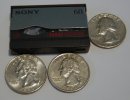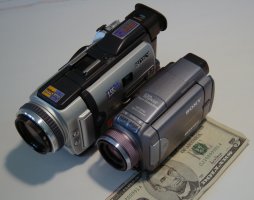Manifest Technology Blog
-- Site:
| Articles
| Galleries
| Resources
| DVI Tech
| About
| Site Map
|
Articles:
| PC Video
| Web Media
| DVD & CD
| Portable Media
| Digital Imaging
| Wireless Media
| Home Media
| Tech & Society
|
PC Video: |
PC Video Articles |
Video Software Gallery |
Video Editing Resources |
Video Editing with Sony's MICROMV (7/2003)
(Sony MovieShaker, Pinnacle Studio 8,
Ulead Video Studio
7)
by Douglas Dixon
MICROMV Format
MPEG Issues
Sony MICROMV Camcorders
Sony MovieShaker
Pinnacle Studio 8
Sony EZ Editor
Ulead VideoStudio 7
Prime-Time MPEG
References
Sony's MICROMV format has brought the trend of miniaturizing video
equipment to a whole new level. If you thought "Mini" DV tapes and
camcorders were small, then this next step was certainly to "micro" --
with 70 percent smaller tape cartridges, and cameras that weigh under one pound.
Even compared to Mini-DV camcorders, these MICROMV units are significantly
lighter to pack and carry, and small enough skip the camera case and just carry
in a coat pocket (www.sony.com/micromv).


 MICROMV cassette
MICROMV cassette
How small is the MICROMV cassette? You can describe it as smaller than a
matchbox, or about the size of two quarters, or smaller and thinner than half a
MiniDV cassette. That is small, indeed.
As this kind of equipment gets smaller and smaller, however, there comes a
point when the trade-offs become too severe, as the LCD screens get too small to
view details and the buttons become too tiny to control reliably with your
fingers. These really are personal preferences, however, and depend on how the
camcorder fits into your hands and with your shooting style.
But MICROMV also introduces another significant trade-off: while these
camcorders connect to your computer with a FireWire interface, they do not
record digital video in DV format. As a result, they do not interface directly
with the wide variety of video editing and DVD authoring tools that can capture
and process video directly from DV equipment. Instead, Sony provides its own
MovieShaker video editing application with to import and edit digital video.
MovieShaker also can convert MICROMV video to other formats (including DV), and
convert video files back to MICROMV format to export back to the camera.
This situation improved in early 2003, as Sony introduced new MICROMV camera
models. At the same time, new versions of the Pinnacle Studio 8 and Ulead
VideoStudio 7 consumer video editing tools were introduced with some MICROMV
support. However, you will see from my experience in working with these new
products, the MICROMV experience is still nowhere near as smooth as working in
DV format.
The basic concept with MICROMV was to shrink the size of the tape cartridge
in order to also reduce the size of camcorders that use the format. As a result,
there is less tape surface in the cartridge than in a Mini-DV cassette, which
means fewer bits available to store an hour of video on a tape. As a result,
MICROMV requires more aggressive compression of the video data.
 Sony DV and MICROMV Camcorders
Sony DV and MICROMV Camcorders
DV compresses video to 25 Mbps (million bits per second), which is relatively
light compression that gives very high quality video. (If you compare this to
using JPEG compression on each individual frame as if it were a digital photo,
it's equivalent to compressing 720 x 480 photos to around 100 KB, which still is
plenty of bits for great looking images.)
In comparison, video for DVD is typically compressed to around 4 to 6 Mbps
using the MPEG-2 format. Since it is highly compressed, MPEG is thought of as a
delivery format for the final output of an edited production, while DV is an
editing and archival format to save the original video. While DV compression can
be done in real time on low-cost chips in any DV camcorder, getting great
looking MPEG video for DVD requires significantly more processing and sometimes
manual tweaking.
For MICROMV, Sony also uses MPEG-2 format, but at a higher 12 Mbps rate. By
increasing the data rate, the camcorder hardware can be designed to still create
good-looking video while compressing in real time. You may notice more artifacts
such as color fringing than with DV, especially in difficult shooting situation,
but the end result is certainly quite good quality. MICROMV also is prone to
introducing blockiness at the start of clips and a freeze-frame at the end of
each clip, so you will need to be careful to keep the camera running a little
longer so you can trim your captured clips.
But using MPEG-2 for MICROMV creates other trade-offs. First, the format is
incompatible with the wide variety of existing software that can interface to DV
camcorders through FireWire connections. After the DV / FireWire interface
finally has become ubiquitous and reliable, we're back to square one in
requiring special software to interface to video capture hardware.
Second, the MPEG data from the MICROMV camcorders is stored as a MPEG-2
"transport" stream, a format for packaging video intended for
transmitting data. Unfortunately, most video editing tools are designed to read
MPEG-2 "program" streams, the expected format for packaging and
storing MPEG-2 video and audio in files. This means that the MMV files created
by Sony's MovieShaker application cannot be read by many video player and
editing tools.
Finally, because of the basic nature of MPEG-2 compression, video files in
MPEG-2 format are difficult to rapidly search, and not really amenable to
frame-accurate editing. Unlike DV, which compresses each frame individually,
MPEG-2 achieves much better compression by storing some frames only as
differences from adjacent frames. After all, since video frames are shot only
1/30th of a second apart, consecutive frames really do not change very much.
MPEG takes advantage of this by analyzing the movement between frames (from a
panning camera or motion in the scene), and then describing a frame in terms of
background and foreground information from adjacent frames.
MPEG-2 uses an "IBP" compression pattern, with groups of frames
starting with a larger I (Intra) frame, compressed individually, followed by
smaller P and B difference frames (Predicted and Bidirectional). The B frames
actually use difference information from both proceeding and following frames.
(MPEG-1 uses a much simpler format, and therefore is easier to edit but
obviously does not produce the same compression quality.)
Now imagine trying to rapidly shuttle through a MPEG-2 video stream. You
cannot easily jump to a specific frame, since consecutive frames vary wildly in
size. If you start trying to decode an arbitrary P or B frame you will end up
with a blocky mess, because they depend on previous and even following frames
that you do not have available.
Even worse, even if you find the right frame where you want to make a
frame-accurate edit, the repeating IBP pattern of the data means that you cannot
simply slap in a new frame exactly where you want it. You can either just force
all edits to the closest I frame, as some applications do, or you need to
uncompress the entire IBP group, edit in your changes, and then recompress the
block again. This is not only a lot of work, but continued decompression and
recompression of already heavily-compressed MPEG-2 video will quickly cause
visible artifacts.
More fundamentally, since MPEG-2 is designed as a delivery medium for playing
full-motion video, when you step in slow motion through individual frames the
stand-alone I frames clearly look better than the P and B difference frames. As
a result, you may not like the visual effect of a cut at the exact frame where
you would like to make it.
As a result of all this, while many video player applications now can play
MPEG-2 files, they can be sluggish when skipping or shuttling through MPEG-2
files, much less when trying to step backwards. Similarly, many video editing
tools really are not designed for MPEG-2 editing. They may import MPEG-2
material, but again they struggle when moving and positioning within the files,
and do not support actually editing the IBP data, but instead decompress into a
more convenient format.
Working with MPEG-2 really requires an editor that understands and processes
MPEG-2 in its native format. Otherwise, your best solution is to transcode from
MPEG-2 to a better-supported format like DV to use for editing in your favorite
applications.
I tried out the Sony DCR-IP55 MICROMV camcorder, introduced in August
2002. It is actually a bit larger than the previous DCR-IP5, introduced in
January 2002, which weighed only 12 oz, with battery, and measured 1 7/8 x 4 x 3
1/8". The upgraded features in the DCR-IP55 include 520 lines of horizontal
resolution and a 1 megapixel imager for still images (MSRP $1,499). It includes
10X optical zoom, pop-up flash, NightShot mode for dark scenes, and Memory Stick
media for still photos and MPEG movies.



Sony DCR-IP5
&
Sony DCR-IP55 MicroMV camcorders
The DCR-IP55 has several interesting design elements to accommodate its small
size (15 oz without battery, and 2 3/8 x 2 7/8 x 5 1/8"). Since there is
limited room for dedicated buttons on the case, the swing-out 2 1/2" LCD
has a touch screen, with both play controls and access to the menus through a
tabbed interface. Sony also designed a swing-down handgrip on one side of the
cam to make it easier to hold the camera steady. The handgrip covers the tape
door, and actually holds the removable battery.
The DCR-IP220 Network Handycam Camcorder has an very different design, with a
larger lens barrel and the camcorder mechanism along the side (at 1 lb. 2 oz,
and 3 7/8" x 3 x 5 3/8). It has 530 lines of resolution and a 2 megapixel
imager (MSRP $1,999).
These cameras include Bluetooth networking technology and can actually take
video and still images recorded on the Memory Stick and email or post them to
the Internet using a Bluetooth modem.
All MICROMV camcorders include FireWire interfaces, also called IEEE 1394, or
iLINK by Sony. The cassettes hold 60 minutes of video. All MICROMV cassettes
include a 64 Kb Cassette Memory chip that provides a visual index of the clips
on the tape.
Sony's MovieShaker application version 3.1 ships with the MICROMV
camera, and is explicitly designed to support the format and camera features on
Windows machines. It imports and exports clips directly from and to the camera,
and reads and writes clips to disk in MMV format.
The MovieShaker interface has a center Monitor panel area, with a Clip tray
on the left, a Tool panel on the right, and the Product tray on along the
bottom. The MovieShaker workflow follows the tabs above the Monitor to progress
from Capture to Editing, first importing clips into the Clip tray, then
assembling them as a storyboard in the Product tray, applying edits from the
Tool palettes for Effects, Text, Transitions, and Narration, and then clicking
Export to save the resulting movie.

One major advantage of using MovieShaker for importing from the camera is the
ability to preview the clips stored on the tape. Click the Scan button under the
Capture tab, and MovieShaker will shuttle rapidly through the tape, extract
thumbnails for each clip, and display them in the Index tray in the Tool
palette. You then can select individual clips and click Batch Capture to have
MovieShaker capture them. Or click Dubbing to capture all the index clips from
the tape.
You also can use MovieShaker to import and export video from and to the
camera, and to convert to DV or another format to process the video using your
other favorite tools. The MMV files created by MovieShaker are in MPEG-2
transport stream format, and therefore are not directly readable by many
applications. I found that QuickTime Player 6 could import and play some MMV
files reasonably well, although it could not handle others. Microsoft Media
Player also could play the files, but only after they were renamed to MPG.
When you use MovieShaker to convert to DV format, it warns that the operation
is going to take a long time. This is irritating in these days of real-time
software DV to MPEG transcoding and DV-based previews, but not much slower than
similar applications.
Pinnacle Studio 8, released in June 2002, combines video editing with
DVD authoring (www.pinnaclesys.com). It
can transcode during capture from DV to MPEG, and can import and edit MPEG-1 and
MPEG-2 files. For DVD authoring, Studio can create DVD, VideoCD, and Super
VideoCD, supports nested menus, and motion menus and buttons. Studio 8 is
available for $99, or bundled with a FireWire card for $129 (MSRP).

Studio 8 supports importing video directly from a MICROMV camera, using
device control to position the tape from the Studio interface. It also can
export video back to the camera, after you have manually positioned the tape and
started recording.
As Studio imports the MICROMV video, it converts it on the fly to a standard
MPEG-2 program stream before writing the data to disk. Because of this
processing, it does not display the incoming video while capturing. The captured
video then is stored as a MPG file, which means it can be read and processed by
a wider range of applications.
Even though Studio can read MPEG-2 files, it is not a native IBP MPEG-2
editor. Shuttling through a MPEG-2 file during editing was sluggish on my
system, so you really need to convert MPEG-2 data to DV before doing any
interesting editing with it.
Studio 8 also is bundled by Sony in its EZ Editor product. The Sony EZ
Editor Video Editing Kit for MICROMV cameras includes all the hardware and
software needed to hook up to a MICROMV camcorder, including a FireWire (IEEE
1394) PCI card, Pinnacle Studio software version 8 SE, plus a FireWire cable, a
MICROMV cassette and a CD-R, for $99 (MSRP).
Ulead VideoStudio 7, released in February 2003, provides real-time
capture, edit and output in a consumer-level video editing tool (www.ulead.com/vs).
It adds support for Windows Media and DivX format. For DVD authoring,
VideoStudio 7 supports VR format from set-top DVD recorders and can create a DVD
from the editing project without needing to first save the output video.
VideoStudio 7 is available for $99 (MSRP).

VideoStudio 7 supports MICROMV format in that is has a new capture plug-in
that can import video from a MICROMV camera and write it to disk in MPEG format.
VideoStudio also cannot read the MMV format files created by MovieShaker.
VideoStudio 7 is described by Ulead as a native MPEG-2 IBP video editor, and
ships with sample MPEG clips. Unfortunately, VideoStudio hung for tens on
seconds on one of my test systems whenever I moved the jog bar to jump around in
the file, and still worked fine on another system. Unfortunately, this kind of
behavior is still too common under Windows as you load multiple applications on
a system along with their support files, and find them interfering with each
other to access their preferred interfaces to decoders, encoders, capture
devices, and other kinds of drivers.
Unfortunately, MICROMV's MPEG-2 video just is not yet a prime-time format for
editing with common PC-based tools. Beyond the lack of support and sluggish
behavior of video players and editors when moving around MPEG-2 files, you
really cannot edit and re-edit MPEG-2 video without quickly causing visible
artifacts.
Another issue is that while MICROMV video has shot time information like DV,
this data is lost in converting to other formats. And even if you use
MovieShaker to automatically capture your video into individual scenes, you then
have to manually export each shot into a separate file to import into another
application.
In addition, even the captured and transcoded MICROMV video exhibited various
problems. Some clips broke up with blockiness or green blotches, especially
between different shots when the camera was stopped and restarted. Some longer
clips exhibited choppy audio or audio sync problems, sliding more than a second
within a ten-minute clip. Other files seemed to end with bad data, as tools like
Adobe Premiere 6.5 could play the file cleanly, but hung when trying to
transcode the last few frames to DV.
Even with these frustrations in working with the MICROMV format, it still is
clear that things are improving and that there are effective options for editing
MICROMV video. The cameras are wonderfully light and easy to use and the video
quality on the tiny tapes is reasonable. Just be aware that the software side is
still limited, and so you will need to experiment with the different options.
Much like getting used to working with such a small camera depends on your
personal preferences, working with MICROMV video on your computer also depends
on your ability to adapt to the available software tools.
Sony - MICROMV
www.sony.com/micromv
Pinnacle Systems - Studio 8
www.pinnaclesys.com
Ulead Systems - Ulead VideoStudio 7
www.ulead.com/vs
|
